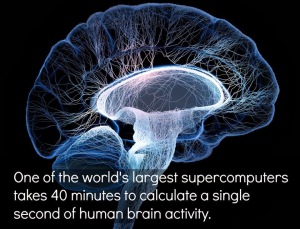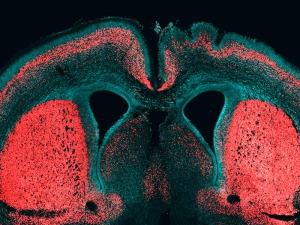In the study of human evolution, one conundrum has always vexed us: how did humans evolve such powerful brains?
Few Differences in Chimp and Human DNA
The genome of Homo sapiens is remarkably similar to those of our closest extant relatives, the common chimpanzee (Pan troglodytes) and the pigmy chimpanzee, or bonobo (Pan paniscus). On the sequence level, we share 98.94% of our DNA perfectly in common. Fully one-third of the genes shared by humans and chimps are so conserved that the proteins they encode are identical. Of the other two-thirds, almost all contain one or two differences, out of hundreds of amino acids each.
This raises the question: how is the human brain so much more powerful than the chimp brain when, genetically, we’re so similar?
Fortunately, the few genetic differences between humans and chimps seem not to be scattered randomly. Instead, there are isolated genomic regions that contain many differences. Most notably, entire genes have been duplicated and subsequently mutated. These “hot spots” or “islands” of unique genetic elements, give scientists a clue about where and how to look for the genes that make our brains so much more than a chimp’s brain.
Big Differences in Chimp and Human Brains
The differences between the human and chimp brain are found almost entirely in one region – the neocortex – which is found right behind our foreheads, the most anterior part of the frontal lobe. The rest of our brains are essentially identical, with minuscule differences here and there, although the human brain is also much larger. Truth be told, much of our brains, other than the neocortex, is quite similar to that of all mammals. The key differences are right up front, in the neocortex.
Not surprisingly, the neocortex is where higher cognitive functions are housed. We know this not just from anatomical-functional experiments with other animals, but also from the study of humans with lesions in this region from stroke or injury. Also, some cool experiments have been done with patients undergoing brain surgery while awake.
The neocortex contains our personality, emotions, thoughts, dreams, as well as our computations, abstractions, and creativity. It contains our language and speech centers and stores our semantic memories. In a very real sense, our neocortex is “who we are.”
Neocortices are unique to mammals and greatly expanded in primates, whose cortex developed deep grooves and folds to allow even more surface area. The neocortex of humans is absolutely enormous compared to other primates. An oft-cited statistic is that the human brain is three times larger than that of the chimpanzee. What is even more astonishing is that almost all of that growth is found in the cerebral cortex and the cerebellum.
The Hunt for the Genes for Big Brains
With this in mind, scientists have been on the hunt for genes that led to the rapid expansion of the human neocortex. Two recent reports have identified candidate genes.
Scientists working at the Max Planck Institute in Germany identified 56 candidate genes that are “unique” to humans in the sense that they are the products of recent gene duplication. When a gene gets duplicated, this is often a vehicle for powerful evolutionary change because one copy is free to mutate and acquire new functions, while the other copy retains whatever vital function that the original gene performs. This is a way to escape the usual rule that mutations are almost always harmful because they result in a defective gene. With two (or more!) copies, random tinkering caused by mutations is tolerated, opening up new avenues for innovation.
These scientists then focused on one recently duplicated gene, ARHGAP11B, because they noticed that it is expressed in regions of the human brain that are uniquely huge. They took this gene and placed it into mice embryos to see what would happen. The results were striking.
Mice that contained a copy of the human ARHGAP11B gene developed brains with much larger neocortices. In addition, their entire cerebral cortex developed the grooves and folds, called sulci and gyri, found in the brains of higher animals. (Rodent cortices are typically smooth.) This is powerful evidence that ARHGAP11B plays an important role in the development of the human neocortex.
Almost simultaneously, researchers at Duke University completed a similar experiment. This time, the scientists focused not on a unique gene, but a gene enhancer that is unique to humans. Enhancers are non-coding regions of our genome that help control how much or how little a gene is expressed. They are part of the “volume control” dials for genes.
The enhancer that these scientists focused on was called HARE5. HARE5 was selected from a list of noncoding elements found to be different between humans and chimps because it controls the expression of a gene known to be involved in nervous system development, the Wnt receptor FZD8, making it a good candidate for influencing the evolution of the human brain.
Once again, the scientists created transgenic mice, this time with the human HARE5 element controlling expression of the mouse FZD8 gene. However, in this experiment, the scientists also generated transgenic mice with the chimpanzee HARE5 element. This way, differences between the human and chimp HARE5 enhancers could be revealed.
The scientists found that placing the mouse FZD8 gene under the control of either the human or chimp HARE5 enhancer resulted in mice with bigger brains due to larger neocortices. These mice also showed the primate-like grooves and folds in their neocortices. This confirms the role of this noncoding genetic element in the expansion of the primate brain.
However, even more fascinatingly, the mice with the human HARE5 element (shown below on the right) developed even bigger brains than those with the chimpanzee version of HARE5 (shown on the left). This makes HARE5 a very strong candidate for being one of the crucial genes for the development of the large and complex human brain.
These two results represent, for the first time, solid clues about the precise genetic mutations that facilitated the rapid expansion of the neocortex in the Homo sapiens ancestry. By studying ARHGAP11B and HARE5 (and I’m sure more candidates will be revealed), we may come to understand what makes us uniquely human.
Epilogue: Science Fiction Becoming Science Fact
These genes and others like them almost certainly function in the murky matter of the genetics of human intelligence. The science fiction nerd in me cannot help but note that we have just taken quite a big step toward having the knowledge necessary to create transgenic humans with superior intellectual abilities. (KAAAAHHHNNNNN!!!)
Will we do it? I’m quite sure that ethical constraints will prevent us from doing so any time soon. After all, the technology for cloning and transgenics has been available for some time and, to date, no one has applied them to humans.
However, creating transgenic animals with improved intelligence would not be as controversial, rightly or wrongly. I think it is reasonable to expect that, within the next decade, we will create a transgenic animal with genetically enhanced intelligence, probably a mouse. Given my firm believe that animals have more cognitive awareness than most people think, this will raise a brand-new ethical concern: once created, what will we do with a highly intelligent and sentient animal?
-NHL





This boggles my neocortex.
LikeLiked by 1 person
lol, that’s the idea!
LikeLike
Reblogged this on a political idealist..
LikeLike
Companions the creator seeks, not corpses, not herds and
believers. Fellow creators the creator seeks—those who write
new values on new tablets. Companions the creator seeks, and
fellow harvesters; for everything about him is ripe for the
harvest.
—Friedrich Nietzsche,
“Thus Spoke Zarathustra”, Datalinks
Breakthroughs in Biomachinery and Doctrine: Initiative paved the way for a new kind of organism that is equal parts biological and computer. The biological aspect thrives at physical manipulation and emotional experience, while the digital aspect excels at calculation and data processing. This Homo Superior integrates the best of biological and machine.
LikeLike
What about the cerebellum ? It increase in size proportionately with the neocortex. And in contrast to what was believed in the past that it concerns only with coordination of movement, advances in neuroscience prove that it has cognitive and affective functions besides its typical motor role. I think we shall never ignore the potential role of the enlarged cerebellum in making us unique creature.
LikeLike
I think you meant “KHHHAAAANNNNN!”
LikeLike